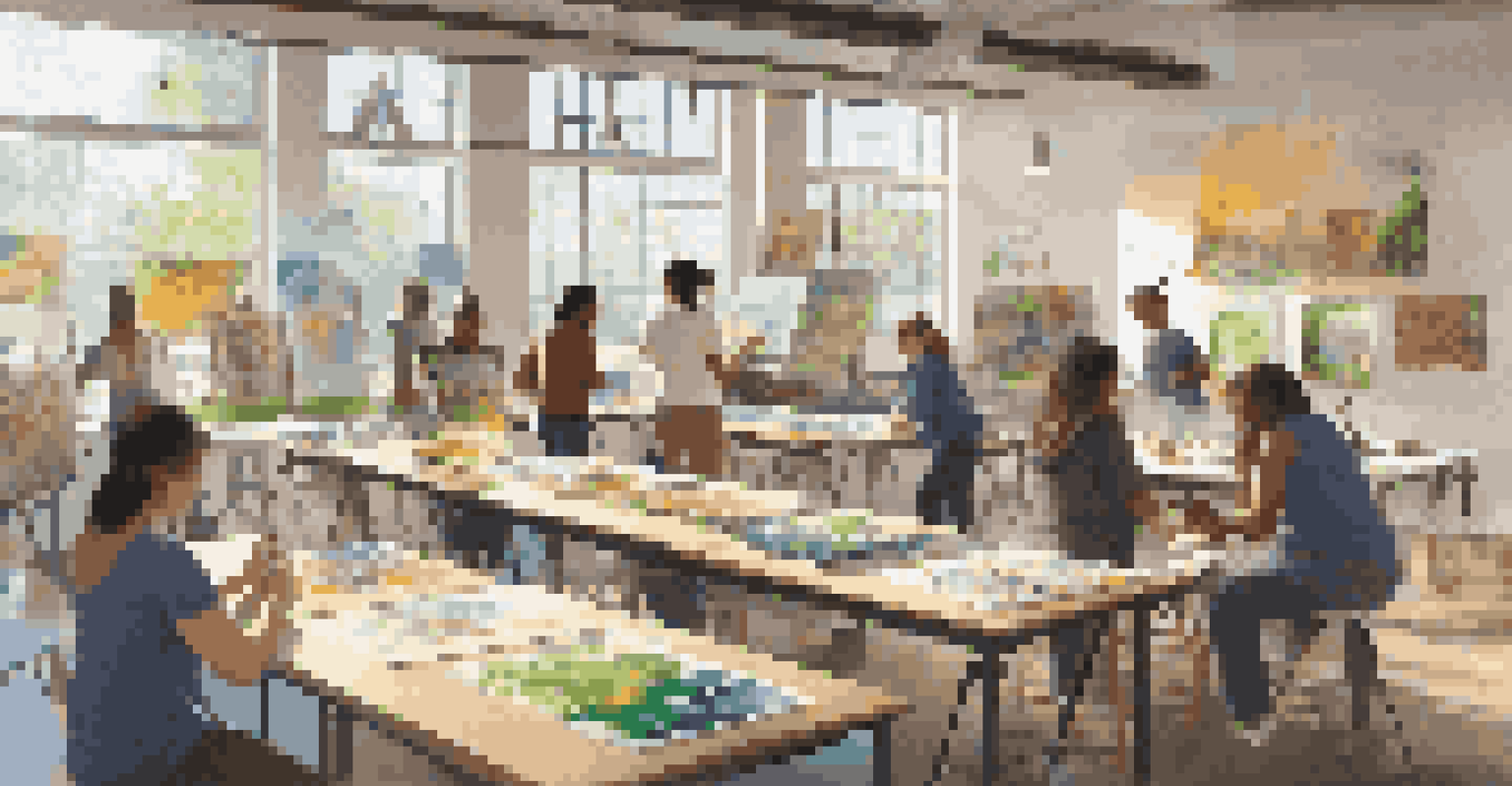Art and the Climate Crisis: A Call to Action for Creatives

The Role of Art in Highlighting Climate Issues
Art has always been a mirror reflecting society's challenges, and the climate crisis is no exception. Through various forms—like paintings, sculptures, and installations—artists can evoke emotions and provoke thought on environmental issues. For instance, a powerful photograph of melting glaciers can make the abstract concept of climate change feel immediate and personal.
Art is not a mirror held up to reality, but a hammer with which to shape it.
Moreover, art can transcend language barriers, making complex issues accessible to a broader audience. When people engage with art that speaks to climate challenges, it can inspire them to consider their own impact on the environment. This emotional connection often motivates viewers to take action, whether it's changing their habits or advocating for policy change.
Additionally, art can spark conversations that lead to community engagement and activism. When artists collaborate with scientists and environmentalists, they can create works that not only inform but also mobilize people to join the fight against climate change.
How Creatives Can Use Art for Advocacy
Creatives have a unique platform to advocate for climate action through their work. Utilizing their art to raise awareness can take many forms, from public murals to online campaigns that highlight environmental issues. By choosing themes that resonate with audiences, artists can effectively communicate urgent messages about climate change.

For example, a mural depicting the effects of pollution on urban wildlife can engage local communities and inspire them to take better care of their environment. Similarly, social media campaigns featuring artists' works can reach global audiences, spreading awareness far and wide. This digital outreach is especially crucial in our interconnected world.
Art as a Catalyst for Change
Artists play a crucial role in raising awareness and inspiring action on climate issues through their creative expressions.
Furthermore, artists can collaborate with non-profit organizations to amplify their messages. By partnering with groups focused on sustainability, creatives can contribute their talents to campaigns that drive real change and encourage others to join them.
Sustainable Practices in Art Creation
As the climate crisis intensifies, it's vital for artists to adopt sustainable practices in their work. This might involve using eco-friendly materials, minimizing waste, and considering the environmental impact of their creative processes. For instance, artists can explore natural pigments or recycled materials to reduce their carbon footprint.
The greatest threat to our planet is the belief that someone else will save it.
Moreover, sustainable practices can also resonate with audiences, reinforcing the message that art doesn’t have to come at the cost of the planet. When creatives prioritize sustainability, they set an example for others, encouraging a shift toward more conscious consumption and production methods in the art world.
Incorporating sustainability into the creative process not only benefits the environment but can also inspire new artistic expressions. Artists who embrace eco-friendly practices often find innovative ways to convey their messages, blending artistry with activism in a meaningful way.
Community Engagement Through Art
Art can be a powerful tool for community engagement, especially when addressing climate issues. By involving local communities in the creation of public art projects, artists can foster a sense of ownership and responsibility toward their environment. This collaboration often leads to a deeper understanding of the local ecosystem and its challenges.
For example, community workshops centered around creating environmental-themed art can empower participants to share their stories and experiences related to climate change. This not only raises awareness but also builds connections among community members, encouraging collective action.
Sustainability in Art Practices
Adopting eco-friendly materials and methods can help artists reduce their environmental impact while promoting a culture of sustainability.
Additionally, art festivals and exhibitions focused on sustainability can bring people together to celebrate creativity while advocating for environmental stewardship. These events often inspire participants and attendees alike to think critically about their relationship with the planet.
The Impact of Digital Art in Climate Activism
In today's digital age, art has taken on new forms, including digital illustrations, animations, and virtual reality experiences. These mediums can be particularly effective in climate activism, as they reach a diverse audience across various platforms. For instance, an animated video illustrating the effects of global warming can quickly go viral, spreading awareness to millions.
Digital art also allows for innovative storytelling techniques that can captivate viewers and elicit emotional responses. By using interactive elements, artists can engage audiences in ways that traditional art forms may not. This interactivity can lead to a more profound understanding of complex climate issues.
Moreover, social media serves as a vital outlet for digital artists to share their work and connect with like-minded individuals. By harnessing the power of online communities, artists can amplify their message and inspire collective action against climate change.
Art as a Reflection of Hope and Resilience
While the climate crisis poses serious challenges, art can also serve as a beacon of hope and resilience. Many artists choose to focus on solutions and positive change, creating uplifting works that inspire action and optimism. For example, installations showcasing successful conservation efforts can remind viewers that progress is possible.
Art that highlights stories of resilience can motivate individuals and communities to believe in their ability to make a difference. By sharing narratives of triumph against climate challenges, artists can instill a sense of empowerment in their audiences. This feeling of agency is crucial in a world that can often feel overwhelming.
Community Engagement Through Art
Involving local communities in art projects fosters a sense of responsibility and collective action toward addressing climate challenges.
Furthermore, art can foster a sense of community and solidarity among those fighting for the planet. Collective art projects that celebrate nature and sustainability can unite people, reminding them that they are not alone in their efforts to combat climate change.
A Call to Action for Artists Everywhere
As the climate crisis continues to escalate, the role of artists has never been more critical. Creatives are called to harness their talents to inspire change, raise awareness, and advocate for a sustainable future. By using their platforms to address environmental issues, artists can play a pivotal role in the movement toward climate action.
Whether through visual art, performance, or digital media, every creative can contribute to the conversation about climate change. It’s about finding your voice and sharing it with the world. Remember, even the smallest act of creativity can ripple out and create significant impact.

Ultimately, this is a collective journey, and every artist has the power to make a difference. Embrace the challenge, engage with your community, and let your creativity be a catalyst for positive change in the fight against the climate crisis.